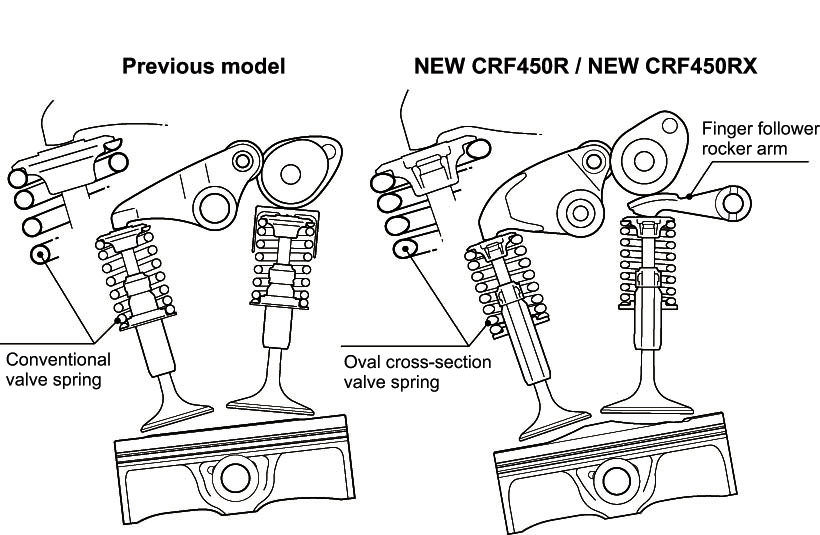Page 1 of 1
Billet 2JZ Cylinder Head with VVT and VTEC
Posted: Sat Nov 04, 2017 9:33 pm
by SHARKBITEATTACK
One of the coolest products I saw at SEMA this year was a prototype of this cylinder head developed for a 2JZ Supra motor. Variable valve timing, variable lift cams, bigger valves and better flow are just some of the benefits that went incorperated into this head.

to the creator.
https://youtu.be/zOTA6yFWMJo
Re: Billet 2JZ Cylinder Head with VVT and VTEC
Posted: Sat Nov 04, 2017 10:36 pm
by user-23911
Making a display piece for a show and making something that works are 2 completely different things.
From the looks of it it's got VVT on the intake cam, VVT on the exhaust cam and switchable cam lobes.
You normally have one or the other but not both.
Controlling it all is a totally different problem.
Need a new computer too.
Instead of the normal buckets that you use with a JZ, this uses rocker arms.
The head is taller and will need a longer cam belt.
Re: Billet 2JZ Cylinder Head with VVT and VTEC
Posted: Sun Nov 05, 2017 8:00 am
by peejay
joe 90 wrote: ↑Sat Nov 04, 2017 10:36 pm
From the looks of it it's got VVT on the intake cam, VVT on the exhaust cam and switchable cam lobes.
You normally have one or the other but not both.
That is the way Honda has been doing it since the advent of the K-series.
Instead of the normal buckets that you use with a JZ, this uses rocker arms.
That's a benefit. You can get a better lift rate with a finger follower than a bucket. That's part of the reason why the Volkswagen 07K engines blow the old 20-valve five cylinder engines out of the water, they can have much more aggressive lobes on the cam.
Re: Billet 2JZ Cylinder Head with VVT and VTEC
Posted: Sun Nov 05, 2017 9:33 am
by panic
What is pictured is a single cylinder mock-up (as in, “not part of an engine”), the actual product doesn't exist in finished form as yet. A flow bench test is not a reliable predictor of port efficiency under high boost conditions - the density, and how it affects the boundary layer, Poiseville, turbulence etc. are nothing like linear vs. light vacuum flow. I think that some variant of CFD may prove useful, but if it's being used (and it's very expensive and slow) it's kept secret so far.
It also replaces those stupid buckets (common automotive use since 1948 - in fact many engines use the same bucket dimensions as the original Jaguar 3.4 DOHC) with a great new idea: rocker arms! You know, what SOHC and VVTi (boo!) still have, and DOHC (yay!) gets rid of? I agree that dual variable makes for a nice taxi engine, but that's not why people spend $30,000 on a GTE. The rocker arms reduce (not increase) the maximum stable valve train RPM by increasing reciprocating mass (as does larger and presumably heavier valves, unless the laws of physics have been suspended).
The wider included valve angle (stem-to-stem in lateral cross-section) may increase VE at speed, or not. Many pent roof engines have been built with included angles from 20° to 90°, and you won't know whether it works until you build one. The oldest engines use the largest angles, does this suggest something?
There are many L6 engines with larger ports and valves that produce far less boosted power than the conventional (non-VVTi) GTE head, so it's not a "given".
"Estimated" price a year ago: $15,000. Didn't mention if valves, springs, etc. included; pistons probably not, but needed due to larger included stem angle = different dome relief cuts and dome volume.
Tell me: has anyone ever seen a project delivered on time and under budget?
Re: Billet 2JZ Cylinder Head with VVT and VTEC
Posted: Sun Nov 05, 2017 10:09 am
by ptuomov
It was my impression that direct acting bucket lifters of sensible diameter allow for a higher maximum valve acceleration but a lower maximum valve velocity than finger followers. Even without variable valve timing, the finger followers seem to give a bit of an advantage over direct acting buckets more often than not. Various variable valve lift and timing applications can be a lot easier to engineer with finger followers. That's my understanding anyway.
In terms of the valve angles, I've read that the angle between the intake port and the exhaust valve should be pretty close to 90 degrees to guide the tumble. That is, the exhaust valve face is a smooth continuation of the intake port. There was a published paper on that. For low compression turbo engines, I don't think the included angles matter that much. It would make sense to me that for normally aspirated engines, the dome size and shape matter so much that the valve included angles are probably very important. Above my pay grade, though.
Re: Billet 2JZ Cylinder Head with VVT and VTEC
Posted: Sun Nov 05, 2017 10:19 am
by hoffman900
The new Honda CRF450R has a single cam with a finger follower and rocker arm set-up:

The the KTMs also do something similar.
They're making well over 130hp/L when they're built and spin to 11,000rpm+ .
Re: Billet 2JZ Cylinder Head with VVT and VTEC
Posted: Sun Nov 05, 2017 11:59 am
by naukkis79
panic wrote: ↑Sun Nov 05, 2017 9:33 am
The rocker arms reduce (not increase) the maximum stable valve train RPM by increasing reciprocating mass (as does larger and presumably heavier valves, unless the laws of physics have been suspended).
Finger follower is the lightest valve follower. Reciprocating mass is much lower than bucket type follower. Finger follower is also much more expensive than bucket type follower setup which is why it's not always used. F1-engines do use finger followers as do BMW S54 and s1000rr engines.
 to the creator.
to the creator. 